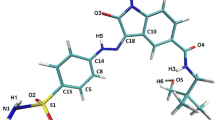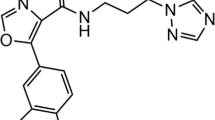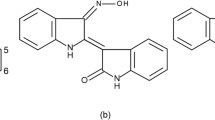Abstract
Glycogen synthase kinase 3 (GSK-3) is an attractive target for the treatment of diabetes, and paullones have been reported to be effective inhibitors of GSK-3. However, it is still a challenging task to improve selectivity among protein kinases, especially cyclin-dependent kinases (CDKs). Here we investigated the mechanism that enables paullones to selectively inhibit GSK-3 rather than cyclin-dependent kinase 5 (CDK5) using sequence alignment, molecular dynamics simulations, free-energy calculations and free-energy decomposition analysis. The results indicate that the interaction between paullones and Val135 of GSK-3 is obviously stronger than that between paullones and Cys83 of CDK5, suggesting that paullones could be utilized as potent selective inhibitors. Meanwhile, we observed that the decrease in the interaction between paullones and the Asp86 of CDK5 favors their selectivity towards GSK-3 rather than CDK5, as demonstrated using 1-azakenpaullone as an example. Although substitution at position 9 and replacement at position 2 may influence the activity of GSK-3, they only have a minor effect on the selectivity. We expect that the information obtained here could prove useful for developing specific paullone inhibitors of GSK-3.

Glycogen synthase kinase-3 is an attractive target for the treatment of diabetes and paullones have been reported to be effective inhibitors of GSK-3. However, how to improve the selectivity among protein kinases is still a challenging task, especially with the cyclin-dependent kinases. Here we investigated the mechanism that enables paullones to selectively inhibit GSK-3 rather than cyclin-dependent kinase 5 (CDK5) using sequence alignment, molecular dynamics simulations, free energy calculations and free energy decomposition analysis









Similar content being viewed by others
References
Zimmet P, Alberti K, Shaw J (2001) Global and societal implications of the diabetes epidemic. Nature 414(6865):782–787
King H, Aubert RE, Herman WH (1998) Global burden of diabetes, 1995–2025. Prevalence, numerical estimates, and projections. Diab Care 21(9):1414–1431
Welsh GI, Proud CG (1993) Glycogen-synthase kinase-3 is rapidly inactivated in response to insulin and phosphorylates eukaryotic initiation-factor elf-2b. Biochem J 294:625–629
Leost M, Schultz C, Link A, Wu YZ, Biernat J, Mandelkow EM et al (2000) Paullones are potent inhibitors of glycogen synthase kinase-3 beta and cyclin-dependent kinase 5/p25. Eur J Biochem 267(19):5983–5994
Martinez A, Alonso M, Castro A, Perez C, Moreno FJ (2002) First non-ATP competitive glycogen synthase kinase 3 beta (GSK-3 beta) inhibitors: thiadiazolidinones (TDZD) as potential drugs for the treatment of Alzheimer’s disease. J Med Chem 45(6):1292–1299
Coghlan MP, Culbert AA, Cross DAE, Corcoran SL, Yates JW, Pearce NJ et al (2000) Selective small molecule inhibitors of glycogen synthase kinase-3 modulate glycogen metabolism and gene transcription. Chem Biol 7(10):793–803
Leclerc S, Garnier M, Hoessel R, Marko D, Bibb JA, Snyder GL et al (2001) Indirubins inhibit glycogen synthase kinase-3 beta and CDK5/P25, two protein kinases involved in abnormal tau phosphorylation in Alzheimer's disease—a property common to most cycline-dependent kinase inhibitors? J Biol Chem 276(1):251–260
Frame S, Cohen P (2001) GSK3 takes centre stage more than 20 years after its discovery. Biochem J 359:1–16
Kunick C, Lauenroth K, Leost M, Meijer L, Lemcke T (2004) 1-Azakenpaullone is a selective inhibitor of glycogen synthase kinase-3 beta. Bioorg Med Chem Lett 14(2):413–416
Stukenbrock H, Mussmann R, Geese M, Ferandin Y, Lozach O, Lemcke T et al (2008) 9-Cyano-1-azapaullone (cazpaullone), a glycogen synthase kinase-3 (GSK-3) inhibitor activating pancreatic beta cell protection and replication. J Med Chem 51(7):2196–2207
Huo SH, Wang JM, Cieplak P, Kollman PA, Kuntz ID (2002) Molecular dynamics and free energy analyses of cathepsin D-inhibitor interactions: insight into structure-based ligand design. J Med Chem 45(7):1412–1419
Kuhn B, Kollman PA (2000) Binding of a diverse set of ligands to avidin and streptavidin: an accurate quantitative prediction of their relative affinities by a combination of molecular mechanics and continuum solvent models. J Med Chem 43(20):3786–3791
Weis A, Katebzadeh K, Soderhjelm P, Nilsson I, Ryde U (2006) Ligand affinities predicted with the MM/PBSA method: dependence on the simulation method and the force field. J Med Chem 49(22):6596–6606
Wang JM, Morin P, Wang W, Kollman PA (2001) Use of MM-PBSA in reproducing the binding free energies to HIV-1 RT of TIBO derivatives and predicting the binding mode to HIV-1 RT of efavirenz by docking and MM-PBSA. J Am Chem Soc 123(22):5221–5230
Hou TJ, Chen K, McLaughlin WA, Lu BZ, Wang W (2006) Computational analysis and prediction of the binding motif and protein interacting partners of the Abl SH3 domain. PLoS Comput Biol 2(1):46–55
Hou TJ, Guo SL, Xu XJ (2002) Predictions of binding of a diverse set of ligands to gelatinase-A by a combination of molecular dynamics and continuum solvent models. J Phys Chem B 106(21):5527–5535
Hou TJ, Yu R (2007) Molecular dynamics and free energy studies on the wild-type and double mutant HIV-1 protease complexed with amprenavir and two amprenavir-related inhibitors: mechanism for binding and drug resistance. J Med Chem 50(6):1177–1188
Wang JM, Hou TJ, Xu XJ (2006) Recent advances in free energy calculations with a combination of molecular mechanics and continuum models. Curr Comput-Aided Drug Des 2(3):287–306
Kollman PA, Massova I, Reyes C, Kuhn B, Huo SH, Chong L et al (2000) Calculating structures and free energies of complex molecules: combining molecular mechanics and continuum models. Acc Chem Res 33(12):889–897
Hou TJ, McLaughlin W, Lu B, Chen K, Wang W (2006) Prediction of binding affinities between the human amphiphysin-1 SH3 domain and its peptide ligands using homology modeling, molecular dynamics and molecular field analysis. J Proteome Res 5(1):32–43
Hou TJ, Zhang W, Case DA, Wang W (2008) Characterization of domain-peptide interaction interface: a case study on the amphiphysin-1 SH3 domain. J Mol Biol 376(4):1201–1214
Gohlke H, Case DA (2004) Converging free energy estimates: MM-PB(GB)SA studies on the protein–protein complex Ras-Raf. J Comput Chem 25(2):238–250
Hou TJ, McLaughlin WA, Wang W (2008) Evaluating the potency of HIV-1 protease drugs to combat resistance. Proteins 71(3):1163–1174
Bertrand JA, Thieffine S, Vulpetti A, Cristiani C, Valsasina B, Knapp S et al (2003) Structural characterization of the GSK-3 beta active site using selective and non-selective ATP-mimetic inhibitors. J Mol Biol 333(2):393–407
Dajani R, Fraser E, Roe SM, Yeo M, Good VM, Thompson V et al (2003) Structural basis for recruitment of glycogen synthase kinase 3 beta to the axin–APC scaffold complex. EMBO J 22(3):494–501
Vanopdenbosch N, Cramer R, Glarrusso FF (1985) Sybyl, the integrated molecular modeling system. J Mol Graph 3(3):110–111
Mapelli M, Massimiliano L, Crovace C, Seeliger MA, Tsai LH, Meijer L et al (2005) Mechanism of CDK5/p25 binding by CDK inhibitors. J Med Chem 48(3):671–679
Case DA, Cheatham TE, Darden T, Gohlke H, Luo R, Merz KM et al (2005) The Amber biomolecular simulation programs. J Comput Chem 26(16):1668–1688
Duan Y, Wu C, Chowdhury S, Lee MC, Xiong GM, Zhang W et al (2003) A point-charge force field for molecular mechanics simulations of proteins based on condensed-phase quantum mechanical calculations. J Comput Chem 24(16):1999–2012
Wang JM, Wolf RM, Caldwell JW, Kollman PA, Case DA (2004) Development and testing of a general amber force field. J Comput Chem 25(9):1157–1174
Jorgensen WL, Chandrasekhar J, Madura JD, Impey RW, Klein ML (1983) Comparison of simple potential functions for simulating liquid water. J Chem Phys 79(2):926–935
Frisch MJ, Trucks GW, Schlegel HB, Scuseria GE, Robb MA, Cheeseman JR et al (2004) Gaussian 03. Gaussian Inc., Wallingford
Bayly CI, Cieplak P, Cornell WD, Kollman PA (1993) A well-behaved electrostatic potential based method using charge restraints for deriving atomic charges—the resp model. J Phys Chem 97(40):10269–10280
Needlema SB, Wunsch CD (1970) A general method applicable to search for similarities in amino acid sequence of 2 proteins. J Mol Biol 48(3):443–453
Kruskal JB (1983) An overview of sequence comparison—time warps, string edits, and macromolecules. Siam Rev 25(2):201–237
Ryckaert JP, Ciccotti G, Berendsen HJC (1977) Numerical-integration of cartesian equations of motion of a system with constraints—molecular-dynamics of N-alkanes. J Comput Phys 23(3):327–341
Berendsen HJC, Postma JPM, Vangunsteren WF, Dinola A, Haak JR (1984) Molecular-dynamics with coupling to an external bath. J Chem Phys 81(8):3684–3690
Darden T, York D, Pedersen L (1993) Particle mesh Ewald—an N.log(N) method for Ewald sums in large systems. J Chem Phys 98(12):10089–10092
Essmann U, Pereral L, Berkowitz ML, Darden T, Lee H, Pedersen LG (1995) A smooth particle mesh Ewald method. J Chem Phys 103(19):8577–8593
Weiser J, Shenkin PS, Still WC (1999) Approximate atomic surfaces from linear combinations of pairwise overlaps (LCPO). J Comput Chem 20(2):217–230
Gohlke H, Kiel C, Case DA (2003) Insights into protein–protein binding by binding free energy calculation and free energy decomposition for the Ras–Raf and Ras–RaIGDS complexes. J Mol Biol 330(4):891–913
Acknowledgments
The project was supported by the National Science and Technology Major Special Project of China (No. 2009ZX09501-011).
We thank Prof. Xiaojie Xu at the Department of Chemistry of Peking University for providing access to computer software such as AMBER.
Author information
Authors and Affiliations
Corresponding author
Electronic supplementary material
Below is the link to the electronic supplementary material.
Esm 1
(DOC 4627 kb)
Rights and permissions
About this article
Cite this article
Chen, Q., Cui, W., Cheng, Y. et al. Studying the mechanism that enables paullones to selectively inhibit glycogen synthase kinase 3 rather than cyclin-dependent kinase 5 by molecular dynamics simulations and free-energy calculations. J Mol Model 17, 795–803 (2011). https://doi.org/10.1007/s00894-010-0762-0
Received:
Accepted:
Published:
Issue Date:
DOI: https://doi.org/10.1007/s00894-010-0762-0




